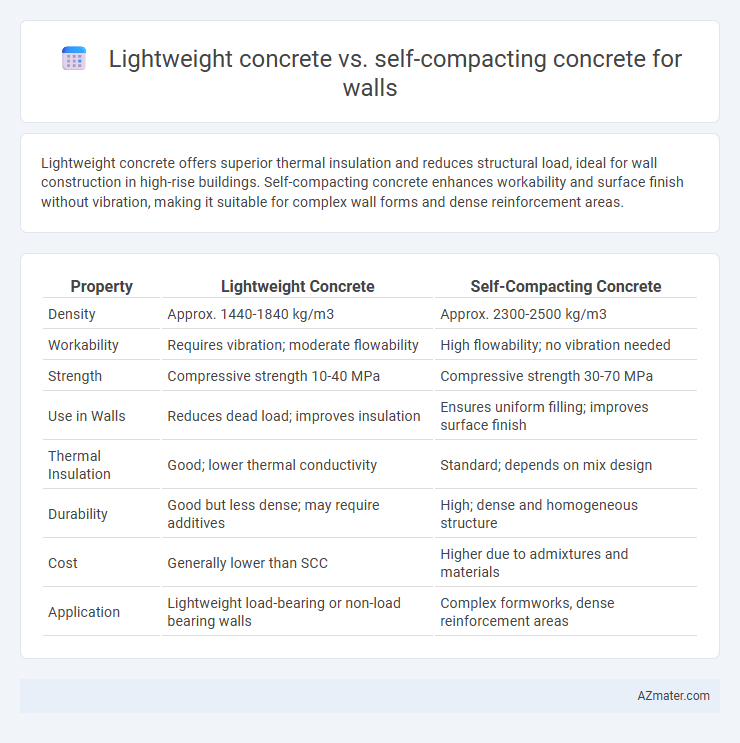Lightweight concrete offers superior thermal insulation and reduces structural load, ideal for wall construction in high-rise buildings. Self-compacting concrete enhances workability and surface finish without vibration, making it suitable for complex wall forms and dense reinforcement areas.
Table of Comparison
| Property | Lightweight Concrete | Self-Compacting Concrete |
|---|---|---|
| Density | Approx. 1440-1840 kg/m3 | Approx. 2300-2500 kg/m3 |
| Workability | Requires vibration; moderate flowability | High flowability; no vibration needed |
| Strength | Compressive strength 10-40 MPa | Compressive strength 30-70 MPa |
| Use in Walls | Reduces dead load; improves insulation | Ensures uniform filling; improves surface finish |
| Thermal Insulation | Good; lower thermal conductivity | Standard; depends on mix design |
| Durability | Good but less dense; may require additives | High; dense and homogeneous structure |
| Cost | Generally lower than SCC | Higher due to admixtures and materials |
| Application | Lightweight load-bearing or non-load bearing walls | Complex formworks, dense reinforcement areas |
Introduction to Lightweight Concrete and Self-Compacting Concrete
Lightweight concrete, characterized by its reduced density and enhanced thermal insulation, is ideal for wall applications that require weight reduction without compromising strength. Self-compacting concrete exhibits superior flowability and eliminates the need for vibration, ensuring uniform filling of complex wall forms and minimizing voids. Both materials address specific construction challenges, with lightweight concrete focusing on load reduction and self-compacting concrete optimizing workability and surface finish.
Composition and Material Differences
Lightweight concrete incorporates lightweight aggregates such as expanded clay, shale, or pumice, resulting in lower density and improved thermal insulation, ideal for walls requiring reduced load and enhanced energy efficiency. Self-compacting concrete contains a higher paste volume with superplasticizers and fine particles like silica fume, enabling it to flow and consolidate under its own weight without vibration, suitable for complex or heavily reinforced wall forms. The key material difference lies in lightweight concrete's focus on aggregate selection for density reduction, whereas self-compacting concrete emphasizes rheology modifiers and particle packing for workability and finish quality.
Workability and Placement Techniques
Lightweight concrete offers improved workability due to its reduced density, making it easier to handle and install on walls, but may require vibration or manual tamping to avoid honeycombing. Self-compacting concrete (SCC) excels in flowability and passes through dense reinforcement without segregation or additional vibration, ensuring superior surface finish and uniformity on vertical surfaces. Placement techniques for lightweight concrete often involve conventional pouring and compaction, whereas SCC relies on gravity flow and casting to achieve optimal distribution and minimize labor.
Structural Performance for Wall Applications
Lightweight concrete offers enhanced thermal insulation and reduced dead load, improving structural efficiency in wall applications by minimizing foundation stress. Self-compacting concrete ensures superior homogeneity and eliminates voids, resulting in increased compressive strength and durability for complex wall forms. For wall structures requiring rapid placement and minimal vibration, self-compacting concrete provides optimal structural performance, whereas lightweight concrete excels in load reduction and thermal performance.
Thermal and Acoustic Insulation Properties
Lightweight concrete exhibits superior thermal insulation due to its low density and high air content, significantly reducing heat transfer in wall applications. Self-compacting concrete offers moderate acoustic insulation but excels in achieving uniform density and smooth finishes, enhancing overall wall integrity. For enhanced thermal and acoustic performance, lightweight concrete is often preferred in wall construction where insulation is critical.
Surface Finish and Aesthetic Considerations
Lightweight concrete offers a porous texture that provides a natural, warm finish ideal for walls requiring enhanced thermal insulation and aesthetic subtlety. Self-compacting concrete delivers a smooth, uniform surface with high precision, minimizing surface voids and honeycombing, which is essential for architectural wall elements demanding superior visual quality. Choosing between lightweight and self-compacting concrete depends on the desired balance between thermal performance and surface finish smoothness in wall applications.
Durability and Long-Term Maintenance
Lightweight concrete offers enhanced durability for walls by reducing dead load and improving thermal insulation, which minimizes cracking and moisture penetration over time. Self-compacting concrete exhibits superior consistency and compaction, leading to fewer voids and increased resistance to environmental factors, thereby reducing long-term maintenance costs. Both materials contribute to durable wall construction, but self-compacting concrete often demands less maintenance due to its uniform density and structural integrity.
Cost Comparison and Economic Viability
Lightweight concrete offers cost advantages through reduced material density and lower transportation expenses, making it economically viable for large-scale wall constructions where load reduction is crucial. Self-compacting concrete, while generally higher in initial cost due to specialized admixtures and precise mix design, reduces labor costs significantly by eliminating the need for vibration and enhancing worksite efficiency. Evaluating total project expenditure, lightweight concrete minimizes structural costs, whereas self-compacting concrete maximizes labor savings and quality control, with the choice depending on specific budget constraints and performance requirements.
Environmental Impact and Sustainability
Lightweight concrete reduces structural load and enhances thermal insulation, lowering energy consumption and carbon footprint during building operation, making it a sustainable choice for walls. Self-compacting concrete minimizes the need for mechanical vibration, improving construction efficiency and reducing noise pollution, but typically requires higher cement content, which may increase embodied carbon. Choosing between the two depends on balancing operational energy savings of lightweight concrete against the improved constructability and potential material intensity of self-compacting concrete for environmentally conscious wall construction.
Choosing the Right Concrete Type for Walls
Lightweight concrete offers enhanced thermal insulation and reduced structural load, making it ideal for energy-efficient wall construction in residential buildings. Self-compacting concrete provides superior workability and eliminates the need for vibration, ensuring smooth, high-quality finishes in complex wall forms and densely reinforced structures. Selecting between lightweight and self-compacting concrete hinges on project priorities such as thermal performance, ease of placement, and structural requirements for wall systems.

Infographic: Lightweight concrete vs Self-compacting concrete for Wall
 azmater.com
azmater.com